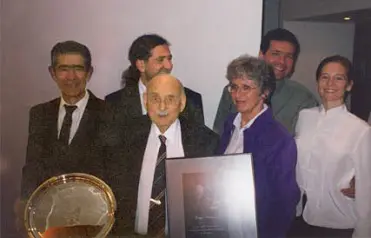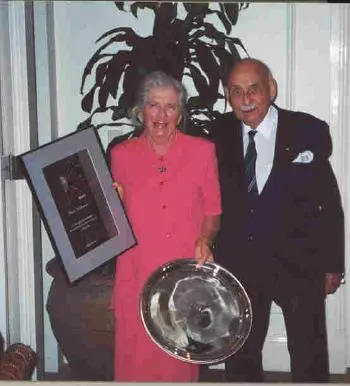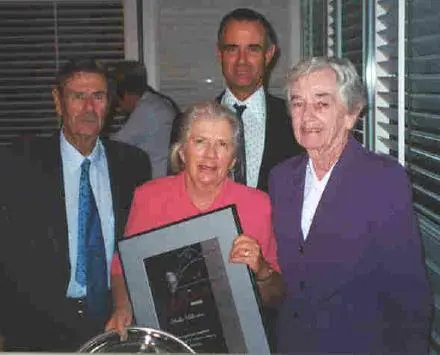The 2002 BH Neumann Awardees were Roger Curnow and Sheila Williams. They were presented with their awards at separate ceremonies and their citations follow.

Roger Curnow receives his Award from Professor Neumann.

From left, Roger Curnow, son Tim, Professor Neumann, wife Gitte, son Richard and daughter-in-law Jenny.
Roger Curnow, for many years a Senior Lecturer in Mathematics at the University of Canberra, received a BH Neumann Award from Professor Neumann at a function at the Atlantic Restaurant, Manuka, Canberra on Friday 14 June 2002.
Roger was born in 1941 near Mudgee, where his father was a primary school teacher. He spent his first 17 years in country NSW, attending, in turn, Port Macquarie, Bexhill, Empire Vale and Ballina primary schools, and Ballina, Orange and Nowra High Schools.
He spent his final school years in a class of one; working essentially by himself. He claims this was a disaster, but it must have served him well for University study.
At Sydney University he found himself in third year doing nothing but mathematics. During the period he absorbed wisdom from all the usual suspects: Smith-White (far and away from his favourite), Prof Room, a young Max Kelly and, he thinks in his first teaching year, John Mack.
He left Syd Uni at the end of 1961 for WRE at Salisbury, then best known as the civilised base for the Woomera but also at the time housing the best computer in the country, an IBM 7090. And though when given a choice between computers and rockets he chose rockets, he has been an IBM fan ever since, because this was, to him, one hell-of-a machine.
Before he was 21 he found himself as nominally in charge of a rocket firing. The next eight years were spent firing rockets and analysing the experimental consequences most of which were related to the density/temperature and tidal motion within the near-space region.
Most of this time he was at Salisbury and Woomera but it included 2 years postgrad work at University College London (1965-66) with rocket firings for ESRO from Sardinia and the British Met Office from South Uist.
Towards the end of 1967, he was back at Salisbury and the next 12 months was spent working on WRESAT, a not oft remembered, but successful Australian satellite.
Following the launch of WRESAT it became apparent that money for near-space research in Australia, never plentiful, was about to disappear altogether. So in 1969, he accepted a job in Operations Research with the Department of Supply/Defence in Canberra and soon found himself an expert in Mathematical Programming and Simulation.
Roger found that the great thing about mathematical modelling skills was their transferability and he spent some time on secondment to the Department of Meteorology.
His inability to salute, and a growing feeling that the Public Service and Department of Defence was not for him, led him to look for other options.
So in 1975 when a lecturing job came up in Operations Research at the Canberra CAE, he applied. Roger believes that Bob Mitchell diverted the Academic Board’s attention to slip him through for an interview, which proved successful. Roger knew Bob from the OR society with which they were both heavily involved for a while (Roger is still the Public Officer for the national society).
After a couple of years of teaching OR subjects Roger complained so loudly about how first-year maths (particularly maths for others) was being taught he found himself landed with the task. Over the next twenty years, he spent an enjoyable time interspersing units in maths programming, general OR units and “maths for others” with the odd tutorial in computing and stats and the odd real maths unit. He probably taught more students than any other mathematician in this period, particularly because of his association with the unit Mathematical Methods. In this role, he developed a reputation as a student-friendly lecturer. He was truly dedicated to the interest of the students, which students recognized, as regular visitors to his office. Roger, being effectively in charge of service teaching of mathematics, also became well known as the face of mathematics in other Schools, such as Applied Science, where he fought very hard to ensure that the students were taught mathematical skills properly, not always endearing himself to the academics in other schools.
Roger became associated with the Australian Mathematics Competition. He thinks he was at the first meeting at Peter O’Halloran’s house but is not on the attendance “list”. However, he has always been a moderator and for many years a member of the AMF Committee. As a moderator, he raised many issues we hadn’t thought of, and although we reluctantly couldn’t always follow his advice, he did always have it right. I remember that he always kept us on our toes with probability questions, where he really improved our methods as a result of his advice.
Roger enjoyed a great association with the late Jo Edwards who started at CCAE the same day as he. Jo was certainly one of the AMC originals and also influenced the way Roger taught maths.
Roger’s main claim to this award is his association with UC Maths Day. Malcolm Brooks and he were listed as the problem committee in its first year in 1982 and they have been ever since, with Roger listed as its Chairman. Roger has enjoyed a strong reputation for many memorable problems over this time, particularly in the design of the famous poster problems, where Roger has been in his element, constructing open-ended problems.
After twenty years and 45 months at the CCAE/UC (not quite enough to qualify for the 25-year pin) Roger took two years to leave without pay from July 1995, to see if he could survive in the “real world”. He worked essentially as an asset consultant which sort of meant financial modelling. Whatever it meant to others, he wasn’t sure, but to him, it meant more mathematical programming and simulation; it did not (thankfully for Roger) mean stochastic calculus.
Roger was also an internal consultant on all matters mathematical/statistical which to him was a lot of fun.
Roger was delighted to have to work with him a couple of ex-students. But he was horrified at the lack of understanding of what a mathematical model is/isn’t by some workmates, a total misunderstanding of what an average is and even worse their (and the population at large’s) feel for probabilities and what they mean.
After 6 years of this, he has decided he is old enough to retire and is now trying sequencing/scheduling techniques in the kitchen, not with a great deal of success.
Despite retirement, he says he expects to continue to be associated with maths day for the foreseeable future.
He hopes also to continue to push mathematics or at least “quant techniques” at the grassroots level whenever and wherever the opportunity arises.
As a few further remarks, we should also note:
Roger had a period on the NSW HSC moderation/scaling committee during the late 80s; and was delighted to be recognised by John Mack after 30 years with “real analysis, 1962”. He was out by a year but impressive never-the-less.
Roger served on the executive of the Canberra Mathematical Association in the late 70s and 80s.
Roger spent 6 months at the Open University in the UK in 1990.
Peter Taylor
Friday 14 June 2002

Sheila Williams receives her Award from Professor Neumann, at the function at Quay West Hotel, Brisbane.

Sheila Williams with Neil (also a holder of this award) and Neil’s parents Colin and Marjory.
On Friday 12 April 2002, Professor BH Neumann presented a BH Neumann Award to Dr Sheila Williams.
Sheila Williams was born in Cornwall. Her parents were both teachers. Her father was, in fact, a school headmaster at Tintagel, on the north coast of Cornwall (where King Arthur is said to have been born).
She passed the notorious 11+ exam when she was ten and went to Sir James Smith’s Grammar School, Camelford. This was a very small school; less than 200 students and about 10 teachers.
However, as is the case with so many of us, Sheila had an inspiring teacher, a Mr Alfred Hooper. He was a local, who, having got a first in mathematics at university, had chosen to go back to Cornwall to teach and those with any mathematical talent blossomed under his tutelage.
When Sheila entered the sixth form she chose for her A level subjects Mathematics, Further Mathematics, Physics and Chemistry. She spent an extra year at school in order to take the Oxford Entrance examination and was fortunate enough to win a scholarship to St Hugh’s College, Oxford.
Here she was fortunate to be at a College with an inspiring tutor, Ida Busbridge, and together with Mr Hooper’s lecture notes, particularly those on projective and Euclidean geometry, progressed very well. One aspect of mathematics which impressed her at the time was the fact that it was sometimes easier to prove a more general result.
It was this sort of idea that made the theorem in her thesis work; the idea came to her while crossing the High in Oxford. As Sheila observed, the great thing about mathematics is that you can do it anywhere!)
After Sheila’s honours degree, she stayed on at Oxford to do a D. Phil. under the supervision of Graham Higman. It was the work in this that gave rise to the “Oates-Powell Theorem” (Oates was Sheila’s maiden name and Martin Powell was also a student of Graham Higman; they each did one case of the result in their respective theses).
Sheila became first a Lecturer and then a Fellow at St Hilda’s College, Oxford, which was the first of the women’s colleges at Oxford to have two mathematics Fellows.
In 1965 Sheila first came to Australia and in 1966 became a Senior Lecturer at the University of Newcastle before going on to the University of Queensland, where she became a Reader, a position she held until her retirement in February 1997. She married Neil in 1979.
Sheila’s first encounter with any form of mathematics enrichment occurred when approached by Henry Finucan, who then ran the QAMT mathematics competition, to supervise one of the sessions held at the University of Queensland. But she was not really involved until Neil became State Director of AMOC in 1981.
For the first few years of his tenure, Neil arranged, whenever possible, for the students he was training to have monthly sessions with an academic at their nearest tertiary institution. Sheila was called in to help and found the experience thoroughly enjoyable.
Around this time, Neil took on responsibility for the QAMT competition, and Sheila found herself rather more involved – as well as supervising a session on the day of the competition, She worked through the problems in the first draft, producing a different set of solutions and looking for mistakes or ambiguities.
Sheila also did the final marking of the top papers in several sections. This is now in the past, as this was one of the many duties that Neil relinquished when he retired last year.
In 1988 Sheila attended the International Mathematical Olympiad in Canberra, as a marking co-ordinator. This she found very interesting; she found that it was quite surprising what languages she could cope with on the strength of her French and Latin – at least when what she was reading was mathematics! It was not long after this that Peter O’Halloran ‘phoned to ask if she would join the AMC Problems Committee. She accepted his invitation with some trepidation but has found it a most rewarding twelve years. Sheila has had a very productive time in this role, and many of the memorable problems in the AMC have been authored by her, especially the ones which contain Cornish names.
Sheila is also a keen needleworker, and is noted for her general knowledge, three times having appeared on the ABC series Mastermind, where she was successful on general questions, and on the special topics “The history of science fiction”, “The works of Lewis Caroll” and “The life and Poldark novels of Winston Graham”. The last one was the most successful – she managed to get into the semifinal.
Since her retirement, Sheila has continued her involvement with mathematics; refereeing and reviewing, as well as working for the QAMT competition and the AMC. She has also been able to indulge another interest of hers, languages, particularly Cornish, which is enjoying a revival after having virtually died out in the eighteenth century.
Peter Taylor
Friday 12 April 2002
